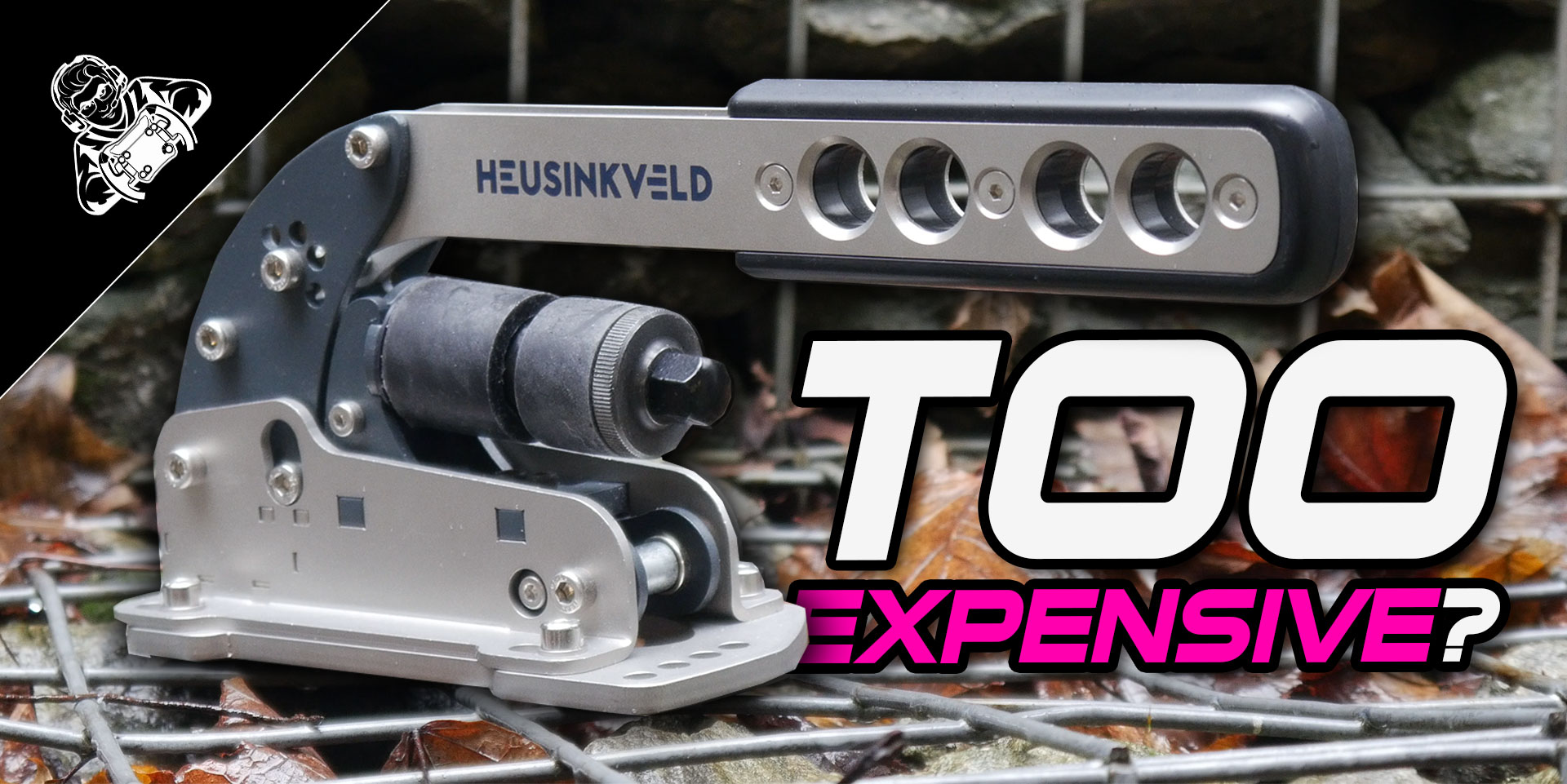

Heusinkveld sprint review
Product link: https://digital-motorsports.com/products/sim-pedals-sprint?aff=2
Introduction
Heusinkveld make some of the best looking pedals on the market. Strategically positioned where the consumer market meets the professional market, these pedals pack a punch and feel and look like real race car parts. The thickness of the materials used, coupled with the sleek design make these an amazing center piece on any rig.
On the left you’ll see the various sections in this review. If there’s a particular section that you wish to jump to, I’ve put a list or clickable timestamps in the description below. While you’re down there, please hit subscribe to stay up to date with videos like this one. Every time a sim racer subscribes to my channel, it helps YouTube to recommend my content to other sim racers.
I used these pedals before I ever got to review them and I really liked them, but you cannot base a real review on occasional use. You need to use the product as if you own it, over an extended period of time, and thanks to digital-Motorsports.com, I’ve gotten the opportunity to do just that.
Setup/installation
The individual pedals come pre-assembled, so if you’re mounting them to your rig’s pedal plate, it should be relatively straight forward using the nuts, bolts and washers provided. However, you’re likely to need to do some drilling if that’s the case, as most base plates simply can not accommodate every possible configuration for your driving style and personal preference. Before you drill holes though, make sure that the pedal base plate on your rig is at least 5mm thick, otherwise you’re very likely to end up buying heusinkveld’s base plate anyway.
That baseplate is extremely durable yet it doesn’t compromise the looks in any way. It is well worth the extra cash as it makes the pedals feel a bit more complete. You can tweak the exact pedal angles and distances to your liking relatively easily.
I did find the base plate more complex to assemble than I thought they would be. This was mainly due to an awkward washer placement for the footrest. I also found that once I had initially assembled them, my feet didn’t sit on the pedal faces correctly, so I needed to raise the foot rest. This involved unbolting half of the pedal base again, including that finicky washer which I probably should have just ignored after the first few times it slipped out during assembly.
Once assembled though, it all looks and feels worth the effort. The mounting holes underneath the base place are the same as the Thrustmaster mounting points. This means that they fit quite easily to most rigs.
Again I found the nuts and bolts and washers a little finicky. I’d like to see threaded nuts welded to the metal structure so that I need one less spanner and have one less tiny part to worry about keeping in place while clambering under my rig’s pedal plate to see if the holes line up.
Software
A quick google search reveals the heusinkveld control centre software which has an easy calibration function, allowing you to easily configure how you want the pedals to behave. You don’t have to make full use of the 60kg load cell if you don’t want to. Truth be told, I didn’t. Not that I don’t like the ability to do so, but for reasons I’ll cover later on in this video when I go into detail about the brake pedal.
Throttle
All three pedals use a load cell. That seems somewhat alien as we usually think of the brake pedal only when we mention load cells. but heusinkveld prefer that approach to using a potentiometer or magnetic encoder.
The throttle feels good out of the box. I’m used to slightly longer travel than the default, so I adjusted it slightly. I like the longer setting because I frequently drive cars without traction control, and having a throttle pedal which gives good confidence really helps with those tricky corner exits. You also appreciate a high quality, dependable throttle pedal like this when it comes to slight lift offs in high speed sections.
Clutch
As with the throttle, a load cell is used for the clutch. It has a good throw and a good weight to it. There’s a bite point in the clutch travel which is simulated by a hinged mechanism, similar to some other pedal sets. This is quite nice and one of the better ones that I’ve used, but it’s a little bit difficult to simulate all the different types of clutch pedal out there. The solution they offer is fairly middle of the road in terms of mimicking what a fast road car would do, or what a real competition clutch feels like.
Brake
This is the one we all want to know about. Out of the box, i found the dampers too hard on this brake pedal. But that’s partly due to the fact that I’m not too impressed by the brake, in general. Don’t get me wrong, it’s a good sim racing brake. In fact, it’s one of the best in the consumer market. But it doesn’t feel quite like any real life brakes that I’ve ever used. Granted, I don’t race a race car every weekend so I might be totally wrong; but a real brake tends to have a slight dead zone at the start and as you press it you feel hydraulic pressure building up along with a nice progressive throw towards full braking power.
Although the sprints are better than the clubsport v3s (with performance kit), they still fall far short of what a brake should feel like for me. It really does feel like I’m pushing my foot against a thick metal car panel rather than pressing a brake.
Don’t get me wrong, these are some of the best sim racing pedals for the consumer market and they’re easy to get used to and be consistent with. But I feel that the whole world of ‘braking’ in sim racing is still in its infancy. We are learning to use load cells, rather than simulating real braking. I’ll revisit this in my final thoughts section.
Adjustment
There’s loads of adjustment available. From the height of the footrest to the faces of the pedals. You can angle the pedals and space them whatever way suits you thanks to this well engineered base plate. The throw of each of the pedals is easy to adjust by moving the bump stop. You can also adjust the angles of the pedals independently which is a major bonus for certain driving styles.
The kit comes with all the little spanners and Allen keys you need, although I’d really like to see less tooling being required, considering the potential simplicity of the assembly.
Final thought
These are well worth the money. Honestly, before I ever tried them, I thought that they were just a well designed, well marketed version of a relatively average pedal set. I still feel that they’re not perfect but they’re light years ahead of any non load cell pedal sets, and also leave the fanatec offerings for dead in their default form.
As I mentioned, sim racing still has quite a bit to go when it comes to pedals. Like that resistance in a throttle that seems to get light when the wheels spin up, or that connection that a real car has between the gear stick and the clutch which gives you that confidence to pin it, as well as that awareness to back off.
And as for brakes, I think that load cell technology is great, but not yet where we need true brake pedal simulation to be. Every time you brake in a real car, it’s slightly different, but intuitive and communicative. Those variables and those tiny little bits of feedback that help you to anticipate or release a lockup are absolutely essential if we are to properly simulate real racing. For now, you cannot go wrong with a set of HS sprints, as there’s nothing readily available for the consumer market out there that matches their performance.
Ultimately, we just want a pedal set that makes us confident and consistent, and this pedal set may do that better than any other, depending on your preference.
But realistically, if you take any consumer grade load cell pedal sets and if you could somehow mate them to a real car on a real track, you would be lacking a proper connection to one of the most fundament parts of your car, your brakes.
The issues I outline in this video are not unique to this pedal set, and please see this as a general discussion of where sim racing is in 2020, rather than a negative reflection of this amazing product which feels premium from unboxing right through to the competitive league races that I have used them for over the past few weeks.
I have never had the fortune of trying out the Heusinkveld Ultimates, and would love to do that comparison at some stage in the future, but until then, the sprints have risen to the top of my list of consumer grade, readily available pedals.
As we continue to expect more from our sim racing products, it’s great to see companies like digital-Motorsports.com supplying and selling products like these, as well as providing opportunities for people like me to share our opinions and our in depth reviews. I recommend having a look at their entire range of pedals to let your imagination wander into the possibilities of what could be.
I’m Laurence and I hope you enjoyed this review.




